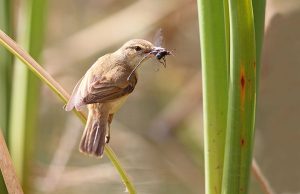By Ian Davidson and Chris Tzaros – Wangaratta Landcare & Sustainability
The Australian Reed-Warbler is more often heard than seen, but can be observed at times climbing amongst reeds and other water vegetation or making short low flights across water. They were originally named the Clamorous Reed-warbler after its similarities with bird species from the Middle East and southern Asia, but was recently confirmed to be a separate species in Australia. They make a rich, melodious song: ‘twitchee-twitchee-twitchee-quarty-quarty-quarty” at regular intervals especially prior to breeding.
The Australian Reed-Warbler is plain olive-brown above, with white underparts tinged golden-orange, and has a pale eyebrow. The sexes are similar.
Locally, the Australian Reed-Warbler is mainly a warm season visitor from northern Australia, migrating south to breed. They are found in wetlands, along waterways and in large dams, wherever suitable tall aquatic vegetation like cumbungi and tall reeds occur.
The Australian Reed-Warbler builds a deep cup nest with a narrow top opening in amongst dense reeds. It is made from dry reeds and other water plants woven together and lined with fine dry grass and feathers. The nest is attached to reeds and is designed to prevent the eggs from rolling out even when the reeds are bent down by high winds or being drowned when water levels suddenly rise. The female incubates the eggs.
This species usually forages individually but sometimes in pairs on insects and spiders and occasionally molluscs and seeds. The Australian Reed-Warbler forages amongst dense reedy vegetation and in surrounding shrubs and woodlands where it can be seen gleaning arthropods from vegetation.
The Australian Reed-Warbler is easy to locate locally at places with dense reeds in water, for example, in Wangaratta at Merriwa Park and the adjoining Kaluna Park. In Wodonga you’ll find them in Clyde Cameron Reserve and Ward Morrison Park and in Albury at Wonga Wetlands and Horseshoe Lagoon. They are also frequent visitors to the Allan’s Flat Waterhole.
Hearing is the easy bit but with a bit of patience the observer may be rewarded when these birds emerge to feed or give their “clamorous” call from the edge of the reeds.


